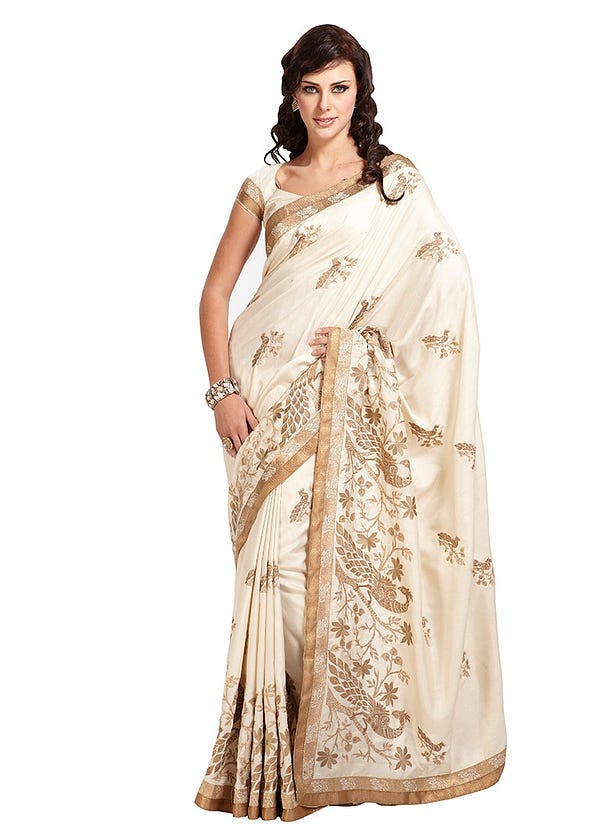Saree Biography
Source (google.com.pk)The saree is one of the world’s oldest and perhaps the only surviving unstitched garment from the past. Over the millennia, it has not only become a sensuous, glamorous all-time-wear for women, but also the ‘canvas’ for weavers and printers to create artistic weaves, prints and jewelled or gold-silver embellishments!
They say cotton and the art of weaving it into fabric came to India from the Mesopotamian civilisation. The men and women of the contemporary Indus Valley Civilisation were therefore familiar with cotton fabrics and wore long pieces of material which could best be described as loin cloths. These lengths of fabric were worn in the kachcha style, meaning that after draping it around the waist, the wearer passed one end of the cloth or the centre pleat between the legs and tucked it up behind to facilitate freer movement of the lower body and the legs. Early history records that this style of clothing was not only limited to Mesopotamia or the Indus Valley but was common to Egypt, Sumer, and Assyria. The relics of all these civilisations, now available in seals and figurines, prove this fact. Women of most of these civilisations, it seems from available evidence, wore only such loin cloths, leaving the upper part of the body bare, except in winter when animal skins or woollen shawl-like garments were used for protection from harsh weather.
When the Aryans came into the plains of the mighty north Indian rivers, they brought with them the word vastra for the first time. Though a Sanskrit word originally meaning a garment or cloth, for them it was a piece of treated leather made into wearable clothing. Their wardrobes also included woollen clothing as they lived in colder climates. As they moved southwards, they adopted the practice of wearing cotton weaves, in the manner of the Indus Valley inhabitants. In time, this style of wearing a length of cloth around the waist, especially for women, and the cloth itself came to be known as neevi. Therefore, it is quite likely that the simple loin cloth worn by the women of the Indus Valley civilisation was the early precursor of the many-splendoured saree of India.
In the epics of India, which were written much after the Indus Valley period, several assorted items of dress were described. The kanchuki, mentioned in many of the legends which form the narrative of the epics, was a piece of cloth worn across the breasts by women. It was probably the earliest form of the choli. Many women, featuring in the classical literature generated by the epics, were described as beautiful in clothes made from silks encrusted with gold and gems.
Though centuries have passed since the saree was conceived as the Indian woman's hereditary costume, the charm of this beautiful and extraordinary feminine garment, suited to the youngest of girls or the most elderly among woman, has not waned. In fact, even with each new decade of technological progress, it has been well accepted by even the most modern women of the subcontinent. Today, its chequered history has become hazy and lost in the distant past. In spite of the limited scope for any change in the garment, it seems to have a limitless future because of the endless experimentation used to recreate its beauty for every new generation of women.
Thus, in the modern world, it continues to be an economical and easy-to-wear garment, suitable for work, leisure or luxury. Over a period of time, several cities in India have become renowned saree manufacturing centres. Each centre is known for creating traditional sarees which have acquired their names not only from the cities of their origin, but also from the weaving or printing techniques used or the motifs, colours or designs utilised in their manufacture. Throughout the history of textile development in India, the saree continues to be produced on handlooms, powerlooms and in gigantic mills with the most modern machinery in all these famous cities.
Even in the modern age, women continue to buy sarees with great enthusiasm, especially during festivals and wedding seasons.
Saree Sherwani Designs 2014 For Groom By Manish Malhotra By Amir Adnan By Junaid Jamshed By Deepak Perwani Photos

Saree Sherwani Designs 2014 For Groom By Manish Malhotra By Amir Adnan By Junaid Jamshed By Deepak Perwani Photos

Saree Sherwani Designs 2014 For Groom By Manish Malhotra By Amir Adnan By Junaid Jamshed By Deepak Perwani Photos

Saree Sherwani Designs 2014 For Groom By Manish Malhotra By Amir Adnan By Junaid Jamshed By Deepak Perwani Photos

Saree Sherwani Designs 2014 For Groom By Manish Malhotra By Amir Adnan By Junaid Jamshed By Deepak Perwani Photos

Saree Sherwani Designs 2014 For Groom By Manish Malhotra By Amir Adnan By Junaid Jamshed By Deepak Perwani Photos
Saree Sherwani Designs 2014 For Groom By Manish Malhotra By Amir Adnan By Junaid Jamshed By Deepak Perwani Photos

Saree Sherwani Designs 2014 For Groom By Manish Malhotra By Amir Adnan By Junaid Jamshed By Deepak Perwani Photos

Saree Sherwani Designs 2014 For Groom By Manish Malhotra By Amir Adnan By Junaid Jamshed By Deepak Perwani Photos

Saree Sherwani Designs 2014 For Groom By Manish Malhotra By Amir Adnan By Junaid Jamshed By Deepak Perwani Photos


No comments:
Post a Comment